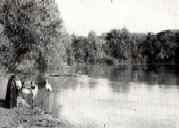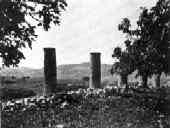- MENASHEH
- BASHAN/GOLAN HEIGHTS
- NAVE
- GILGAL
- JORDAN RIVER VALLEY
- SAMARIA
- SHECHEM
Menasheh was born in the Land of Egypt, the first born of Joseph by Osnat, daughter of Potiphar, priest of On. According to Genesis 41:51, Joseph named him “Menasheh” because “…god has made me forget (נשני Nashani ) all my toil…” referring to the time when he was sold by his brothers to a caravan going to Egypt, and his subsequent imprisonment in Egypt. The Bible refers to the descendants of Menasheh as a “half tribe”, probably because he was not the son of Jacob. By the time the Children of Israel were on the edge of the Promised Land, Menasheh was divided into east and west. The eastern portion of the tribe settled in their lands first. In Numbers 32:33 and 39, it is stated that eastern Menasheh took possession of the lands of Gilead and Bashan, which stretched as far as the town of Edrei in the east and, what is now known as the Golan Heights in the west. The cities of eastern Menasheh are listed in scattered places in the Bible, but mainly in Numbers 32:41 and Joshua 13:30-31: Ashtarot, a royal city of Bashan, Edrei, another royal city where Og, King of Bashan, was defeated and his lands given over to Menasheh, Golan, set aside by Joshua as a city of refuge and was held by the Gershon branch of the Levites, the Havot Yair bloc, Nobah, and Salchah. Of Salchah nothing is known but the fact that it was a boundary city.
The western portion of the tribe took possession of its land during the time of Joshua. Roughly, this territory consisted of the lands from the Carmel mountain range and across the Jezreel Valley to the Jordan, including the towns of Megiddo and Bet She’an in the north, and going southward, until the northern border of Jaffa in the west, the southern border of Shechem in the center, and the southern border of Gilgal in the east, thus, consisting of the bulk of the Jordan Valley. The cities of Menasheh on the west side of the Jordan, many of which were shared with the tribe of Ephraim, are listed in Joshua 17. (I’ve divided these cities between those behind, what we know today, as the “green line” from those outside of it.) Those behind the “green line” are as follows: Bet She’an, Dor, Ein Dor, Ible’am, Megiddo, Michmetah, and Taanach. In, what is known today as the West Bank, the cities were: Ein Tappuah, Gilgal, Shechem, and Shomron.
---BASHAN/GOLAN HEIGHTS
After the Biblical period, and in course of time, various Druze and Arab clans as well as Circassians from the Caucasus migrated to the area and some Jews also remained. In the 7th century, the indigenous Jews were joined by Jewish refugees from Khaibar in Arabia, who were expelled by Mohammed, especially the tribes of Kainuka and Wuld Ali, who settled among the native Jews in Edrei. Later joined by other Jews, Edrei became a rabbinic center in the Middle Ages. Early in the 14th century, questions arose as to whether certain parts east of the Jordan, which included the Edrei area, were halachically, a part of the Land of Israel and therefore, obligated to observe the laws that only applied to Israel. After constant debate, which lasted for over two centuries, it was decided in the affirmative and Edrei and the surrounding area were officially proclaimed a part of the Land of Israel.
During the 11th century, there was also a relatively large Jewish community in Banias. They were referred to as Baniasites who were frequently mentioned in the documents of the Cairo Geniza. Since Babylonian Jews had also settled in Banias, the community split into Palestinians and Babylonians, who differed in their version of prayers. These two sections existed throughout the 12th century. A Karaite pseudo-messiah, Solomon Hakohen, was reported as having appeared in Banias in 1102 and the famous proselyte Obadiah the Norman passed through the area. However, Benjamin of Tudela, in c. 1170, mentions no community at all and it is possible that it had ceased to exist during the Crusader period. Later, Banias was re-inhabited by Jews as were some of the other villages in the Bashan area. During the early Ottoman period, Banias still had a Jewish population as attested by a document from 1624 which mentions the murder of a Jewish physician, by the name of Elijah ha-Kohen, by an Arab sheikh. Apparently, by the 19th century, no Jews were left in the Golan/Bashan area and it was, in general, only sparsely inhabited.
In 1880, Laurence Oliphant published Eretz ha-Gilad (The Land of Gilead), which described a plan for large scale Jewish settlement in the Golan, but the Turks snubbed the scheme. In 1884 there were still open stretches of uncultivated land between villages in the lower Golan, but by 1886, members of the old yishuv in Safed formed the Bet Yehuda Society and purchased 14,000 dunams of land near the Circassian village of Ramthaniya, in the central Golan. But due to financial hardships and the long wait for a kushan (Ottoman land deed) the village, Golan be-Bashan, was abandoned after a year. Soon afterwards, the society regrouped and purchased land in the nearby Bedouin village of Bir Shaqum in the southern Golan. Thus, the village of Bnei Yehuda was established. Between 1891 and 1894, Baron Edmond James de Rothschild purchased nearly 80,000 dunams (30 miles sq.) of land consisting of 16 villages in, what is today, southern Syria for Jewish settlement. Most of the land was situated in the eastern Golan and straddling both sides of the Nahr el Allan. Today, it lies just a few kilometres from the 1967 lines, inside Syria where Jews are forbidden to live.
The Russian Agudat Achim Association acquired land in several locations in the districts of Fiq and Daraa and at Jillin where a farm was built and extensive eucalyptus groves were planted. Other tracts of land were acquired by Jewish organizations based in Romania, Bulgaria, the United States, and England, but Jewish settlement in the area remained slow and tenuous. Meanwhile, Jews had managed to build a road stretching from Lake Huleh to Muzayrib and by the mid-1890s most of the Golan had become owned and cultivated by a variety of peoples. A Jewish village called Tiferet Binyamin was set up on lands at Saham el-Jolan by the Shavei Zion Association based in New York, but the project was abandoned after a year when the Turks issued an edict in 1896 evicting the residents on the grounds that they were not Ottoman citizens. A later attempt to resettle the land with Syrian Jews who were Turkish citizens, also failed. In 1899, the Pasha of Damascus expelled the Jews from all of Rothschild's estates. Between 1904–08, a group of Crimean Jews settled in the Bethsaida Valley, initially as tenants of a Kurdish proprietor with the prospects of purchasing the land, but the arrangement faltered. Jewish settlement in the region was abandoned over time, either due to Arab hostility and Turkish bureaucracy, disease, or economic difficulties.
Until 1920, a few Jews returned to the Golan. But that year witnessed the first of a series of Arab pogroms which raged throughout the country resulting the massacres and expulsions of Palestinian Jews whether they were immigrants or not. Bnei Yehuda was one such victim community when, in 1920, the last remaining inhabitants left following an Arab attack. But the land itself was still owned by Jews. From 1921–1930, when the British authorities in Palestine gave that piece of land to the French authorities in Syria, the Palestine Jewish Colonization Association (PJCA) obtained the deeds to the Rothschild estate and continued to manage it, collecting rents from the Arab peasants living there. In 1944 the JNF bought the Bnei Yehuda lands from their Jewish owners. Subsequently though, they lost a lawsuit with the Arabs of Bir Shaqum regarding the Jewish ownership of the land. In that year, the Syrian Land Settlement Campaign refused to recognize the foreign owned PJCA as the legal owners of the land and the Syrian government confiscated it without compensation on the grounds that "it was contrary to Syrian policy to allow Jews to own land in Syria." The JNF still lays claim to the land.
In the period between Israel’s War of Independence and the Six Day War, the Arab countries, including Syria, refused to recognize Israel as a sovereign nation. During this time, the Syrians constantly harassed Israeli border communities by firing artillery shells from their dominant positions on the Golan Heights. In October 1966 Israel brought the matter up before the United Nations. Five nations sponsored a resolution criticizing Syria for its actions but it failed to pass due to a Soviet veto.
Israel’s former Prime Minister Golda Meir summed up life in Israel’s northern border communities adjacent to the Golan as follows:
The Syrians seemed bent on an escalation of the conflict; they kept up an endless bombardment of Israeli settlements below the Golan Heights, and Israeli fishermen and farmers faced what was sometimes virtually daily attacks by snipers. I used to visit the settlements occasionally and watch the settlers go about their work as though there’s nothing at all unusual in plowing with a military escort or putting children to sleep – every single night – in underground air raid shelters.
After the Six-Day War broke out in June 1967, Syria's shelling greatly intensified. The war on the northern front ended when the Israeli army captured the Golan Heights. Israeli settlement in the Golan began soon after the war with the establishment of Merom Golan the following month. By 1970 there were 12 such communities.
---NAVE
This is a small village on the east side of the Jordan almost nothing of which is known. Of the few records found about the place, it was probably allotted to the half-tribe of Menasheh and might be identified with the Biblical village of Nobah as mentioned in Number 32:42. During the Byzantine period, it was probably a seat of Torah learning and in the 5th century, Tanhuma bar Abba, amora of the 5th generation, lived here. It still contained a small Jewish community in the Middle Ages, but eventually, the Jews moved away. Today, the village has no Jews and is likely never to have Jews again as it is located in, what is today, the Kingdom of Jordan.
---GILGAL
The first camping-place of the Israelites in the land west of the Jordan; the place to which they could retreat during their struggles for conquest. According to Joshua 5:9, the place was called “Gilgal” because it was here that the lord said to Joshua, “I have rolled away (Heb. “Gilgal”) the reproach of Egypt from off you…” After the allotment of land to the tribes of Israel, Gilgal became part of Menasheh territory, almost adjacent to the border of Benjamin and right next door to Jericho which was part of Benjamin. The Ephraimite sanctuary, so severely condemned by the Prophets, was probably to be identified with the "Gilgal" of the Joshua narrative. It was also mentioned as a place of sacrifice in I Sam. 10:8. Its name could still be found on the hill Jaljul, east of Jericho but some scholars believe that it is to be identified with Khirbet al Mafjir on the eastern border of Jericho.
Modern Gilgal was established in 1970 as a Nahal settlement and was converted to a civilian kibbutz in 1973. ---JORDAN RIVER VALLEY
In Biblical history the Jordan appears as the scene of several miracles, the first taking place when the part of the river near Jericho, was crossed by the Israelites under Joshua (Josh. Chapt. 3). Later the two tribes of Gad and Reuben and the half tribe of Menasheh that settled east of the Jordan built a large altar on its banks as "a witness" between them and the other tribes (Josh. 22:10). About half the river formed the boundary line between the part of Menasheh on the west side of the river, and the tribes on the east. The tribes of Yissasschar and Naphtali bordered the remainder of the river. The Jordan was crossed over on dry ground by Elijah and Elisha, each of whom divided the waters with a stroke of the mantle (II Kings 2:8, 14).
Before the coming of the Arabs, many Jewish farms dotted the Jordan Valley. But due to persecutions by Crusaders and later by Arabs and other Muslims, the Jews moved away. For centuries thereafter, the Valley became the domain of various Bedouin tribes who often warred against the Mamelukes, Turks, or other Bedouin tribes.
After the War of Independence, the Valley found itself split in two. The northern half, stretching from Tirat Zvi north to the Jordan’s headwaters, became part of Israel. The southern half which stretched down to the Dead Sea and beyond, was under Arab occupation. Jews were banned from the southern half for the next 19 years and only began to return immediately after the Six Day War. The first town established in the Valley was Mechola in 1967 by Bnei Akiva members and named after the biblical city of Abel-mechola (1 Kings 19:16), which was located in the area. The village of Argaman followed and was established in 1968 as a Nahal settlement. It was converted to a civilian moshav in 1971. Its name is an acronym for Arik Regev and Gad Mandel, two Nahal commanders who were killed whilst pursuing terrorists. Massua was established in 1969 as a Nahal settlement, and was converted to a civilian moshav by a HaOved HaTzioni gar'in five years later. Next came Gilgal as was explained above. Since the founding of Gilgal, 17 other communities sprang up in the Valley, not counting that of Maale Efrayim, which is a separate local council and “capital” of the Valley.
---SAMARIA
Samaria (Shomron) was, for a time, the capital of the northern Kingdom of Israel. Although not mentioned in Joshua’s allotment of territory to the tribes of Israel, the city definitely fell in the territory of western Menasheh, just north of Shechem. It was built by Omri, in the seventh year of his reign, on the mountain Shomron; he had bought this mountain for two talents of silver from Shemer, after whom the city was named (I Kings 16:24). After the return from the Babylonian Captivity, the name Samaria, was eventually applied to most of the area that was the northern Kingdom of Israel. The inhabitants at the time, were thus called “Samaritans (Shomronim). Judah kept its name which was later Hellenized to “Judea”. Hence, its inhabitants were called “Jews”.
Under Herod (whose wife was Mariamne) the city of Samaria became the capital of the whole district of Samaria, the city itself being known as Sebaste, the Greek equivalent of the Latin "Augusta," the city being named in honor of Augustus Cæsar. At the outbreak of the Jewish war it was attacked by the Jews. Josephus speaks of soldiers of Sebaste who served in Herod's army and who later sided with the Romans against the Jews. Sebaste is mentioned in the Mishnah where its orchards are praised. Under Septimius Severus it became a Roman colony, but with the growth of Neapolis (Nablus), it lost its importance.
In the fourth century Sebaste was a small town. Jerome records the tradition that Samaria was the burial-place of the prophets Elisha and Obadiah, as well as of John the Baptist. Benjamin of Tudela, however, does not relate that these tombs were shown to him; he states only that traces of Ahab's palace were still visible, and that he found no Jews in the place at all. After the Crusader period, Arab settlers migrated to the site and established the village of Sabastiyah. Visitors in the 19th century have noted that its population was estimated to have been about 400, almost all Arab Muslims and during the late Ottoman period, a train station was built in the village. Jews attempted to return to the site in late 1976 when Gush Emunim sought to establish a settlement at the Ottoman train station. The Israeli government did not approve and the group that was removed from the site would later found the town of Elon Moreh adjacent to Nablus/Shechem.
---SHECHEM
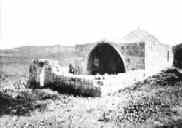
The city of Shechem is an ancient city within the southernmost portion of the territory of Menasheh between Mt. Ebal and Mt. Gerizim near the border with Ephraim. During the time of the Patriarchs, when the land was populated by the Canaanites, the site of Elon Moreh, just to the west of Shechem, became the first place in Canaan that Abraham rested and built an altar to god. In effect, the altar in Elon Moreh became to first Jewish place of worship in history. According to Genesis 33:18-19, the Patriarch Jacob, who, after his meeting with Esau, encamped in front of Shechem in the field which he bought for 100 pieces of money from Hamor, the prince of the country, and he called the place “El Elohei Yisrael”. It was then inhabited by the Hivvites. Jacob's arrival at Shechem marked a very important period in its history; for the rape of Dinah, daughter of Jacob, which took place there, resulted in the pillage of the city and the massacre of all the male inhabitants by Jacob's sons. This narrative shows also that Shechem was at that time a commercial center, and rich in sheep, oxen, and asses. The oak-tree under which Abraham had built an altar still existed in the time of Jacob, who hid under it the images and the earrings of the Shechemites. The surrounding territory afforded good pasturage; and therefore during Jacob's stay at Hebron his sons drove their flocks to Shechem. In the nearby Plain of Dotan, Joseph was sold, by his brothers, as a slave to Egypt. Later in life, Joseph was joined, in Egypt, by his brothers as well as by Jacob. After Joseph’s death, their descendants became slaves there, and when the Israelites returned to Canaan after their long sojourn, they reburied Joseph’s remains in Shechem. His tomb became a place of Jewish pilgrimage throughout the centuries.
During the period of the rule of the judges over the Land of Israel, the inhabitants of Shechem elected Abimelech as king, and solemnly inaugurated him in the temple under the oak-tree. He was overthrown by the people of Shechem after a reign of only three years. After Solomon's death all the tribes of Israel assembled there to crown Solomon’s son Rehoboam as king of Israel. It was there that the ten tribes, whose demands were spurned by Rehoboam, renounced their allegiance to him and elected Jeroboam as king (I Kings 12:1-20). The latter fortified Shechem and made it for a time his capital. It was conquered by the Assyrian kings, and its inhabitants, carried away into captivity, were replaced by colonists from other countries. Although it is debatable, this is probably the origin of the Samaritans who tended to follow the religion of Israel.

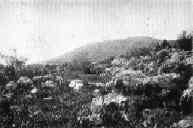
By 1900, Nablus had a population of about 24,000, including 150 Jews, and 170 Samaritans under their High Priest Yakub ben Aharon and the city became a site for many tourists and pilgrims of all nationalities all over the world. In 1905, the English Jewish traveler Elkan Adler, in the course of his tour through Israel, had visited Nablus and while there, obtained a copy of a Samaritan chronicle which he had edited for western audiences.
Later on, because of high taxes and oppression on Jews and Samaritans by the Turks and Arabs, the Jews fled and by 1906, there were no more Jews left in the city. Only the Samaritans remained, however precariously. Attempts to renew Jewish settlement were made in the 1920s, but because of the hostility of the Arabs, such plans were thwarted. During the British Mandate period, Shechem became, even more so, a hotbed of Arab Muslim fanaticism. Pilgrimages to the Tomb of Joseph ceased and did not resume until after the Six Day War. After the War, contact was made between the Shechem Samaritans and those of Holon and their combined populations had grown since. Pilgrimages to the Tomb of Joseph renewed – under heavy armed guard, and eventually, a yeshivah was established on the site, Yeshivat Od Yoseph Hai. At the beginning of the Oslo War in 2000, this yeshivah was expelled by Arab mobs and a Druze soldier, Crprl. Madhat Yusef, who was guarding this Jewish holy site, was wounded by gunfire. Reports say that Prime Minister Ehud Barak, in cooperation with the Arabs and the Israeli army, prevented the army from rescuing him, and they happily watched as Corporal Yusef bled to death. Later, Barak ordered the army to allow the Arabs to take over the site so that they could desecrate it. With Barak’s approval, they set fire to the site and later, painted its dome green, the color of Islam.
Nowadays, the Tomb has been restored and it will be hoped that regular pilgrimages as well as the reestablishment of the yeshivah on the site will take place.



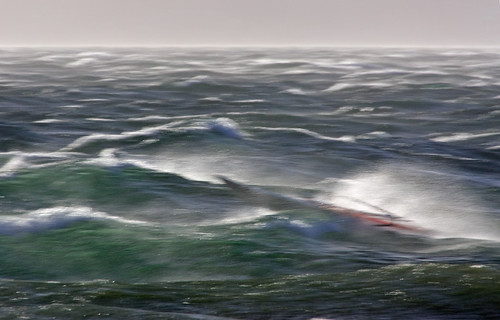


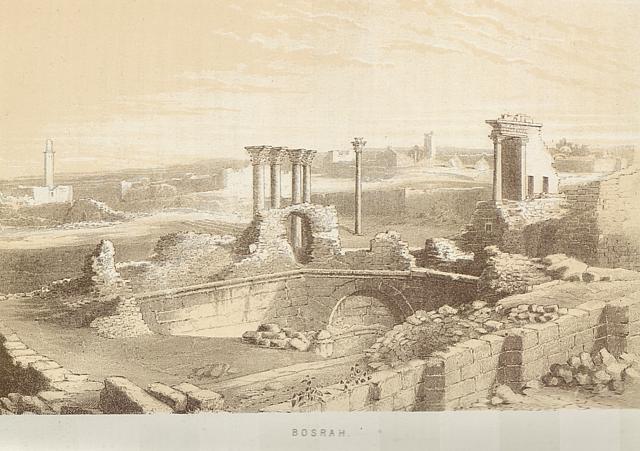
,-where-the-manna...-painting-artwork-print.jpg)
